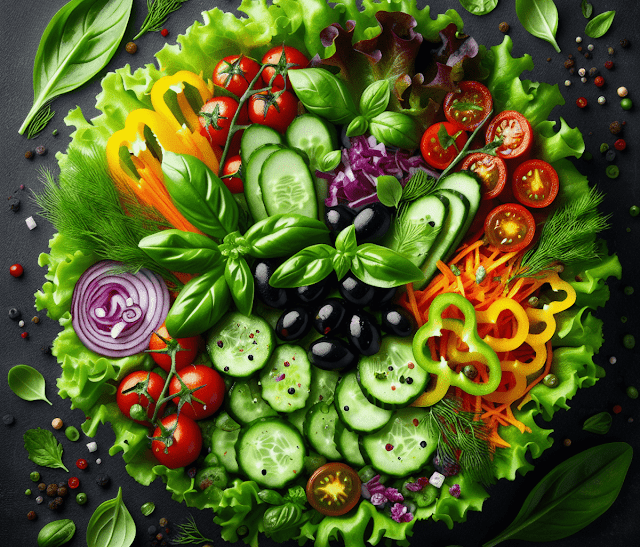Introduction
The Green Mediterranean Diet is a nutrition-rich diet that prioritizes fruits, vegetables, whole grains, nuts, seeds, herbs, spices, and olive oil. It’s a spin on the classic Mediterranean diet but with a stronger emphasis on plant-based foods and sustainability. This diet is good for you and the environment because it prefers low carbon footprint foods.
What sets this diet apart is its focus on high-polyphenol foods like Mankai (duckweed), green tea, walnuts, and other plant superfoods. By eating less meat and more plant-based foods, you can enjoy benefits like better heart health and lower risk for certain illnesses.
In this guide:
- Discover the principles of the Green Mediterranean Diet
- Learn valuable tips to seamlessly integrate this diet into your daily routine
- Enjoy recipes that will invigorate your taste buds and contribute to your well-being
Embracing the Green Mediterranean Diet means making choices that benefit both your body and the planet. Let’s embark on this journey towards a healthier lifestyle and a more sustainable world.
Understanding the Green Mediterranean Diet
At the heart of a healthy lifestyle lies the Mediterranean diet. This traditional eating pattern, native to countries bordering the Mediterranean Sea, is celebrated for its abundant health benefits. Research consistently ties it to lower rates of heart disease, cancer, diabetes, and other chronic conditions. It emphasizes:
- Consumption of fruits, vegetables, whole grains, and healthy fats like olive oil
- Moderate intake of fish and poultry
- Restricted consumption of red meat, saturated fats, and refined sugars
Building upon this foundation is the Green Mediterranean Diet. This innovative approach amplifies the plant-based aspects of the traditional diet and incorporates an environmental perspective. The key principles include:
- A higher intake of plant foods such as whole grains, fruits, vegetables, legumes, nuts, and seeds
- Sustainable options like seasonal produce and locally sourced ingredients
- Preservation of culinary traditions that emphasize fresh food preparation rather than processed alternatives
These principles create diets like the Vegetarian Mediterranean diet. It focuses on fewer animal products and more plant-based foods, similar to the Green Mediterranean Diet.
The Green Mediterranean diet is health-focused, promotes plant consumption, and considers sustainability. It offers a balanced way to wellness for us and our planet.
The Link Between the Green Mediterranean Diet and Wellness
When it comes to the wellness-promoting attributes of the Green Mediterranean diet, the evidence is compelling. This synergistic blend of nutrient-dense foods and sustainable practices can have profound impacts on human health.
Cardiovascular Health
This diet is great for your heart. It has things like green tea, walnuts, and a plant called Mankai. These foods have antioxidants, which are good for you. Olive oil in the diet is good for your cholesterol levels[^1^]. This diet also doesn’t have much salt, which helps keep your blood pressure in check[^2^].
Weight Management
The Green Mediterranean diet is inherently rich in fiber from whole grains, fruits, and vegetables. Fiber not only keeps you satiated but also supports a healthy digestive system[^3^]. As a result, adhering to this dietary model can assist with weight control and even contribute to weight loss.
Enhanced Mood
It’s not just about physical well-being; this diet also benefits your mental health. Research suggests that the combination of complex carbohydrates from whole grains with essential fats from nuts and olive oil may foster regulated mood and improved cognitive function[^4^].
In essence, embracing the Green Mediterranean diet means nurturing your body with foods that simultaneously contribute to personal wellness and planetary sustainability.
References:
[^1^]: Mediterranean diet’s heart benefits [^2^]: Dietary sodium reduction [^3^]: Fiber for Weight loss [^4^]: Carbohydrates and mood
Practical Tips for Adopting a Green Mediterranean Eating Style
The Green Mediterranean Diet begins with a gentle shift towards plant-based foods and Mediterranean ingredients. Here are some actionable strategies to get you started:
Start Small
- Incorporate More Plants: Begin by adding one vegetarian meal to your diet plan each day, such as a hearty lentil stew or a vibrant vegetable stir-fry.
- Swap Animal Proteins: Replace meat with legumes, nuts, or seeds in your favorite recipes. Think chickpea curries or quinoa salads.
Plan Your Meals
- Weekly Menu: Create a weekly menu centered around seasonal produce and whole grains. This ensures variety and helps avoid last-minute unhealthy choices.
- Batch Cooking: Prepare larger portions of grains like farro or barley to use throughout the week, making meal prep faster and easier.
Stock Your Pantry with Essentials
- Whole Grains: Keep staples like brown rice, whole wheat pasta, and oats readily available.
- Legumes: Canned or dried beans, lentils, and chickpeas are versatile for many dishes.
- Nuts & Seeds: Walnuts, almonds, chia seeds, and flaxseeds add crunch and nutrients to meals.
- Herbs & Spices: Mediterranean herbs like oregano, basil, and thyme, along with spices such as cumin and coriander, enhance flavor without added salt.
Make your Green Mediterranean diet journey fun and rewarding. Focus on diverse plant foods and tasty Mediterranean ingredients. Each meal is a chance to nourish yourself and the planet.
Savor the Flavors of the Green Mediterranean Diet: Recipes for Vibrant Health
Diving into the world of Green Mediterranean recipes, you’ll find an abundance of sustainable cooking practices and healthy green Mediterranean dishes that are as good for you as they are for the planet. The Green Mediterranean Diet meal plan is rich in flavors and nutrients, with a wonderful variety of dishes to enjoy at every meal.
Breakfast
Start your day with energy-boosting meals that are both delicious and nutritious. For inspiration, explore these 10 Delicious Mediterranean Diet Breakfast Recipes that include whole grains, fresh fruits, and a rainbow of vegetables.
Lunch: Grilled Eggplant and Chickpea Salad with Lemon-Tahini Dressing
Ingredients:
- 1 large eggplant, sliced and grilled
- 1 cup chickpeas, cooked
- Mixed greens (spinach, arugula, etc.)
- Cherry tomatoes, halved
- Cucumber, sliced
- Red onion, thinly sliced Dressing:
- 3 tablespoons tahini
- Juice of 1 lemon
- 2 cloves garlic, minced
- Salt and pepper to taste Instructions:
- Toss grilled eggplant slices and chickpeas with mixed greens, cherry tomatoes, cucumber, and red onion.
- Whisk together tahini, lemon juice, garlic, salt, and pepper until smooth.
- Drizzle dressing over salad just before serving.
Dinner: Baked Cod with Kale Pesto Crust
Ingredients:
- 4 cod fillets
- 2 cups kale leaves
- 1/4 cup walnuts
- 2 tablespoons olive oil
- 2 cloves garlic
- Salt and pepper to taste Instructions:
- Preheat oven to 375°F (190°C).
- In a food processor, blend kale leaves, walnuts, olive oil, garlic until it forms a pesto.
- Season cod fillets with salt and pepper.
- Spread kale pesto over each fillet.
- Bake for about 15 minutes or until cod is flaky.
Snack: Roasted Red Pepper and White Bean Dip
Ingredients:
- 1 jar roasted red peppers, drained
- 1 can white beans, rinsed and drained
- 2 tablespoons olive oil
- Juice of half a lemon
- Salt and smoked paprika to taste Instructions:
- Combine all ingredients in a food processor.
- Blend until smooth.
- Serve with vegetable sticks or whole-grain pita bread.
Dessert: Olive Oil and Orange Polenta Cake
Ingredients:
- 1 cup polenta (cornmeal)
- 3/4 cup all-purpose flour
- 2 teaspoons baking powder
- Pinch of salt
- Zest of one orange
- 3/4 cup extra-virgin olive oil
- 1 cup sugar Instructions:
- Preheat oven to 350°F (175°C).
- Mix polenta with flour, baking powder, salt, and orange zest.
- In another bowl whisk together olive oil and sugar.
- Combine wet and dry ingredients.
- Pour batter into greased baking pan.
- Bake for about 30 minutes or until golden.
These recipes showcase just a slice of the delicious possibilities within the Vegetarian Mediterranean diet recipes category—each dish bringing traditional flavor combinations to life while prioritizing healthful ingredients.
Considering Sustainability in Your Green Journey
The Green Mediterranean diet isn’t just a pathway to personal health and wellness; it’s a step toward a healthier planet. By emphasizing plant-based foods and sustainable practices, this eating pattern can help reduce greenhouse gas emissions and conserve vital natural resources.
The Carbon Footprint of Food
Every food we consume has a carbon footprint, representing the total greenhouse gas emissions produced during its life cycle – from farm to plate. Animal-based foods tend to have higher carbon footprints due to the resources required for their production.
- Green leafy vegetables in the Mediterranean diet, such as spinach, kale, and collard greens, have significantly lower carbon footprints compared to meats. A shift toward these plant-based foods can therefore contribute towards a sizable reduction in your personal carbon emissions.
Choose Sustainable and Local
Sustainability goes beyond just what you eat; it’s also about how your food is grown. Organic Mediterranean foods are grown without synthetic pesticides or fertilizers, reducing pollution and maintaining soil health.
- Locally sourced Mediterranean cuisine not only supports local farmers but also reduces the environmental impact associated with long-distance food transport. Next time you shop, consider choosing products labeled as locally-grown or organic.
Advocacy for Sustainable Policies
Support policies for sustainable farming and care for the environment. Vote for leaders who fight for these causes or back groups that do the same.
Eating a Green Mediterranean diet helps you and our planet. Every small step you take can make a change.
Embrace the Long-Term Benefits of the Green Mediterranean Lifestyle
The Green Mediterranean Diet helps improve both your health and the planet’s. It offers a sustainable way to nourish your body while respecting the environment. Following this diet brings lasting benefits.
Here are ways to integrate this diet into your life for lasting impact:
Make it a habit
Incorporate the recipes and eating habits from the Green Mediterranean Diet into your daily routine to establish long-term adherence.
Seek variety
Diversify your meals with an array of colorful fruits, vegetables, and whole grains to ensure a spectrum of nutrients and flavors.
Join a community
Connect with others who are passionate about green eating. Together, celebrate successes and navigate challenges.
Educate and inspire
Share what you learn and inspire others. Your story could change someone’s life.
If you’re ready to start or continue your green journey, check out The Ultimate Guide to Embracing the Green Mediterranean Diet. It’s full of useful tips for a healthy and eco-friendly lifestyle.
Adopting this lifestyle is not a trend but an investment in your future. Every plant-based meal improves your health and reduces your environmental impact. As you enjoy the colorful dishes of the Green Mediterranean diet, remember, each meal is a choice for your health and the planet.












